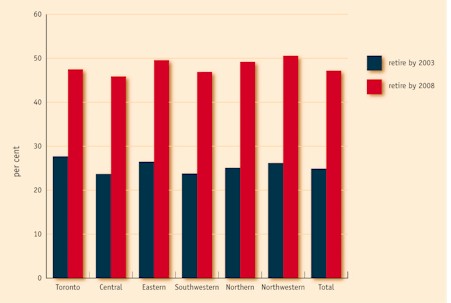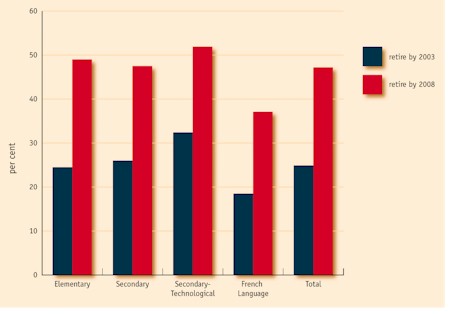Charts and
Sidebars
Our Retirement
Assumptions
Future teacher retirements can be anticipated using
reasonable assumptions about likely age of retirement. The College teacher supply study
uses a model that parallels some of the actuarial assumptions of the Ontario
Teachers’ Pension Plan Board (OTPPB). We project that one-half of teachers who reach
age 55 will retire prior to the next teaching year, 50 per cent of the ever-diminishing
remainder will retire each subsequent year, and those few continuing through to age 65
will retire in the year following that birthday. The model thus projects the retirement of
all teachers at some point between ages 55 and 65.
Elementary and Secondary Teacher Retirements –
5 Years and 10 Years
 |
Elementary and secondary teachers exhibit a similar
age distribution. The teaching profession will lose 24 per cent of teachers with
elementary certification (we grouped Primary-Junior and Junior-Intermediate for this
purpose) to retirement in five years and 49 percent in 10years. For secondary teachers the
corresponding numbers are 26 per cent and 47 per cent.
Note: Some teachers have both elementary and
secondary certificates and are counted under each panel; the total column counts each
individual once.
|
Teacher Retirements by Ontario Region –
5 Years and 10 Years
|
Teacher
Retirements by Certification –
5 Years and 10 Years
 |
The needs in secondary school tech subjects are
changing. The wave of retirements may assist boards in adapting to current, high
technology requirements – but only if the new teachers are available with the
qualifications. The Technology teacher shortage is most pronounced in Metro Toronto,
Northern and Northwestern Ontario where the 10-year turnover is closer to six in 10 than
the provincial five in 10. With fewer than 80 Technology Studies teacher education
candidates enrolled in Ontario’s faculties of education in 1998 – an 18 per cent
decline from 1997 – the staffing crisis is very near in secondary technology
teaching.
|
Retirements
by Secondary School Teaching Subject
 |
Where there is already a high demand relative to
supply – Mathematics, Sciences, Technology, and French – the retirement waves
will exacerbate school boards’ hiring problems. However, the projections reveal no
cause for complacency on the medium-term supply of teachers in English, History and
Geography at the secondary levels.
|
Older Teacher Workforce
Dramatic growth in school enrolment through the 1960s brought
a teacher-hiring explosion to Ontario that drew young teachers to the profession in
unprecedented numbers. This boom generation reachers retirement years in the late
1990s and through the first decade of the 21st century.
Age of Ontario Teachers and Canadian Labour Force
 |
The hiring boom of 30 years ago leaves today an age
distribution among the Ontario teacher population that is markedly different from the
general Canadian workforce. The under-35 component of the Canadian employed population
(41.5 per cent) is almost twice the proportion of Ontario teachers in the same age group
(22.2 per cent). This difference is balanced by a corresponding disproportion among
Ontario teachers aged 45 to 54 – more than two in five Ontario teachers are in this
age group versus only one in five for the general working population.
|
New Entrants Down
At the same time that teacher retirements are rapidly
reducing the supply of experienced teachers, interest in teaching as a career is at a
recent historic low in Ontario. There has been a decline from a peak of 19,800 applicants
to the province’s 11teacher education faculties in 1989, to fewer than 8,000 in each
of the past two years.
|
Ontario
Teacher Education Applicants
 |
Older Male Teachers
The College study reveals that male teachers are older than
female teachers. The difference is mainly evident among teachers whose certification is
Primary-Junior.
Primary-Junior Teacher Retirements by 2008 by Gender
 |
Across the province, the College study projects that
eight per cent to 20 per cent more male Primary-Junior certified teachers will retire by
2008 than female teachers. The reasons for this difference may relate to women entering
the profession at younger ages than men in the 1960s boom years. There may also be some
tendency for women more than men to withdraw from teaching prior to normal retirement age.
Whatever the source of this difference may be, it will add to the problem of an
under-representation of male teachers in elementary schools over the next decade.
|